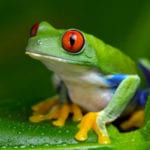 Creepy
Creepy  Creepy
Creepy  Technology
Technology 10 Scientific Breakthroughs of 2025 That’ll Change Everything
 Our World
Our World 10 Ways Icelandic Culture Makes Other Countries Look Boring
 Misconceptions
Misconceptions 10 Common Misconceptions About the Victorian Era
 Mysteries
Mysteries 10 Strange Unexplained Mysteries of 2025
 Miscellaneous
Miscellaneous 10 of History’s Most Bell-Ringing Finishing Moves
 History
History 10 Great Escapes That Ended Right Back in Captivity
 Weird Stuff
Weird Stuff 10 Fascinating Things You Might Not Know About Spiders
 Food
Food 10 Everyday Foods You Didn’t Know Were Invented by the U.S. Military
 History
History 10 Odd Things Colonial Americans Kept at Home
 Creepy
Creepy 10 More Representations of Death from Myth, Legend, and Folktale
 Technology
Technology 10 Scientific Breakthroughs of 2025 That’ll Change Everything
 Our World
Our World 10 Ways Icelandic Culture Makes Other Countries Look Boring
Who's Behind Listverse?

Jamie Frater
Head Editor
Jamie founded Listverse due to an insatiable desire to share fascinating, obscure, and bizarre facts. He has been a guest speaker on numerous national radio and television stations and is a five time published author.
More About Us Misconceptions
Misconceptions 10 Common Misconceptions About the Victorian Era
 Mysteries
Mysteries 10 Strange Unexplained Mysteries of 2025
 Miscellaneous
Miscellaneous 10 of History’s Most Bell-Ringing Finishing Moves
 History
History 10 Great Escapes That Ended Right Back in Captivity
 Weird Stuff
Weird Stuff 10 Fascinating Things You Might Not Know About Spiders
 Food
Food 10 Everyday Foods You Didn’t Know Were Invented by the U.S. Military
 History
History 10 Odd Things Colonial Americans Kept at Home
10 Incredible Animal Facts We Discovered In 2017
With another year almost gone, we have taken a look back at some of the biggest stories from archaeology and space science. Now it is time to see what kind of interesting discoveries we have made in the animal kingdom.
Our understanding of the natural world around us is continually evolving, as new ideas and developments supersede those of the past. There were many unbelievable discoveries made in 2017 that scientists are incredibly excited about. Including some that could lead to significant advances in the fields of medicine and robotics.
10Chimps Can Learn to Play Rock, Paper, Scissors

The gap between humans and our primate cousins got a little bit smaller this year after a Japanese study showed that chimpanzees have the ability to learn the rules of rock, paper, scissors and perform similarly to a four-year-old child.
The experiment was conducted at the Primate Research Institute at Kyoto University and involved seven chimpanzees of differing ages and sexes and 38 children aged three to six who acted as the control group. Just to be clear, the apes did not play the game against one another. Instead, they were shown two hand gestures on a touchscreen and had to choose the winning signal.
During the trials, the chimps took longer to learn the relationships between various combinations than children, who usually corrected their mistakes after one wrong choice. The chimps seemed to struggle particularly hard with the idea that scissors beat paper.[1] The research team’s next goal is to teach chimpanzees how to play against one another.
9Scientists Discover the Hidden City of Octlantis

Octopuses (or octopodes, if you prefer), are considered reclusive animals that usually live in solitude. During the day, they seek shelter inside dens which they typically block with rocks. At night, they go out hunting alone. However, Australian divers discovered a group of octopuses congregating at a site in Jervis Bay, south of Sydney, which puts into question what we thought we knew about this incredible animal.
The site, dubbed Octlantis,[2] consists roughly of two dozen dens made out of rocks and shells. The cephalopods have been observed assembling together, communicating, and even fighting with each other when one octopus got too close to another one’s den. While this is new information, it is not exactly surprising to scientists, as octopuses consistently rank among the most intelligent animals in the world. A bigger challenge is finding out the motivation for this behavior, although protection from predators and access to better food resources seem likely possibilities.
This is not the first discovery of its kind. Back in 2009, also in Jervis Bay, marine biologists found another cephalopod site dubbed Octopolis. However, that community formed around a large man-made metal structure left underwater. Seen as an “artificial reef,” that instance was considered an anomaly, but this new revelation shows that octopuses are, indeed, more social than we previously thought.
8Marine Biologists Find the Spider-Man Snail

A newly-discovered marine snail is drawing comparisons to Marvel’s fictional superhero Spider-Man for its web-shooting abilities. First reported back in April, the worm-snail was named Thylacodes vandyensis after the location where it was discovered, an artificial reef made out of the USNS General Hoyt S. Vanderberg aka the Vandy.
Spider-Man can shoot ultra-resistant spider webs. Similarly, the sea snail has very potent, very large slime glands which it can use to generate mucus. The substance is then shaped into a mucus web which the snail shoots using tiny tentacles in order to nab dinner. Any microorganisms that get stuck on the web are pulled in and strained through a filter-feeding system similar to that of baleen whales.[3] At the same time, scientists have observed that while the mucus web is deployed, fish avoid eating any of the “Spider-Man” snail’s tubes. It is possible the net also contains certain chemical agents that act as deterrents to predators.
7Naked Mole-Rats Have Plant-Like Ability

The naked mole-rat is one of the most bizarre-looking mammals on the planet, but also one of the most intriguing. For reasons we do not quite understand yet, this animal has a lifespan exceeding 30 years which is up to ten times longer than that of other rodents. Although not immune as previously thought, the naked mole-rat is also extremely resistant to cancer. This year, we added another unique trait to the list which explains how the rodent can go 18 minutes without oxygen without suffering any ill effects.
The naked mole-rat has a variety of characteristics which diminishes its oxygen requirements to suit its life as a burrower. It has small lungs, low metabolic and respiratory rates, and its heart rate can drop from 200 to 50 beats per minute in an oxygen-deprived environment. Still, this was not enough to account for the naked mole-rat’s durability in zero-oxygen atmospheres. As it turns out, the animal borrows a trick from plants.
The naked mole-rat’s body is capable of metabolizing fructose instead of glucose, a process which requires little to no oxygen. The resulting energy is delivered to vital areas such as the heart or the brain.[4] Other mammals are capable of using fructose as an alternative energy source, but only under specific conditions and only in certain organs. A transporter molecule named GLUT5 is necessary for this process. While most mammals only have it in their liver and kidney, naked mole-rats have it throughout their entire bodies.
6Fire Ants Build Their Own Eiffel Tower

A new study from the Georgia Institute of Technology looks at fire ants and how they are capable of constructing tall structures out of their own bodies in order to navigate tall obstructions blocking their path.
Generally, these ants can build towers which are several inches tall without a leader or coordinated effort through simple trial-and-error. The ants start with a wide base and build vertically, narrowing the tower as it gets taller to better distribute the weight. Each new ant looks for a space to fill but will walk away if it starts getting crushed. This way, sections which are not structurally sound will break apart and fall away. The fire ants will try again until each one bears an equal load. Several researchers have noticed that the ant structures share multiple characteristics with the iconic Eiffel Tower.[5]
This is not the first time that fire ants proved their engineering prowess. Back in 2014, another study showed that they can also form rafts which are waterproof and can stay afloat for months. Researchers studying these animals are hopeful that understanding the basic rules which govern such complex group behavior can help them, eventually, program robot swarms to act in the same way.
5Tuna Fish Improve Speed and Maneuverability Using Hydraulics

The giant tuna has many characteristics that establish it as one of the ocean’s apex predators. Even though it is one of the largest fish in the world, measuring hundreds of kilograms and up to 4.5m (15 ft) in length, it can still reach speeds exceeding 70 km/h (45 mph). The tuna can do this thanks to a newly-discovered locomotion system which is currently believed to be unique among vertebrates.
The tuna has a special pair of sickle-shaped fins centered above and below the body powered by a biological hydraulic mechanism controlled by the lymphatic system. The tuna can move the fins at different angles in order to increase its speed or maneuverability through the water, depending on the situation. At high speeds, the fish raises the fins to their full extension by pushing lymph fluid into their channels, thus providing extra stability. At slow speeds, lowering the fins means that the tuna has increased agility and can turn on a dime.[6]
The unique physical trait was first observed in bluefin tuna at the Monterey Bay Aquarium. Subsequent examinations performed at a Stanford research center uncovered the strange fluid-filled chambers located below the dorsal and anal fins of the fish. Researchers will keep studying this hydraulic system to understand it better, hoping that it could even be used as a blueprint for faster underwater robots.
4Dragonfly Wings Rip Bacteria Apart

People are spending a lot of money on research and development for bacteria-killing surfaces which would have a wide range of applications in various fields. Several projects are currently in development, such as one for a biomaterial surface coated in antimicrobial silver nanoparticles. Another team created a surface out of black silicon which consists of nanopillars capable of physically ripping bacteria apart. However, as we found out earlier this year, nature did it first using the wings of dragonflies.
On a molecular level, the surface of dragonfly wings resembles a “bed of nails.” However, although initially we thought that this kind of mechanism kills bacteria by puncturing the cell wall, recent research suggests a different method. The bacterium first attaches itself to the nanopillars using extracellular polymeric substances (EPS), natural polymers secreted by microorganisms. It gets stuck on the “nails” and, when it tries to move, the sheer force pulling on the EPSs is enough to rip the membrane apart.[7]
The key difference between dragonfly wings and their black silicon counterparts is the size of the “nails.” While lab-made, artificial nanopillars are the same size, the wing pillars alter between tall and short. However, to truly test the lethality of dragonfly wings, a wide range of bacteria needs to be tested, including ones with varying numbers of membranes or that do not produce EPS. If the wings pass muster, scientists are likely going to be mimicking the design.
3Paleontologists Found an Amphibian Missing Link

Researchers have determined that two fossils belonging to a prehistoric creature represent the missing link between some of the most bizarre amphibians of the Triassic Period and some of the most bizarre amphibians today.
Named Chinlestegophis jenkinsi, the species represents the oldest relative of caecilians, a modern group of limbless amphibians. Found mostly in Africa and South and Central America, caecilians spend most of their time underground, making them very elusive and hard to study. They can measure anywhere from a few centimeters to over a meter in length and resemble worms in appearance. The discovery of Chinlestegophis jenkinsi traces their evolutionary timeline to a group of extinct amphibians called Stereospondyli. They appeared during the Late Permian Period and thrived during the Triassic, becoming the most diverse amphibian group of the era. Notably, they also had a bizarre appearance with their heads likened to a toilet seat.
Up until recently, scientists believed that Stereospondyli represented an evolutionary dead-end, meaning that they were not related to any extant species. However, this new discovery suggests that the current lineage of amphibians evolved from a common ancestor approximately 315 million years ago.[8] One of the members of the team described their findings as “textbook-changing” as it forces paleontologists to re-evaluate the origins and evolutionary history of modern amphibians.
2Scientists Uncover Tardigrade Super Gene

The tardigrade is, undoubtedly, one of science’s most beloved creatures due to all of its puzzling abilities. Less than a millimeter in size, the tardigrade is regularly described as the toughest creature on the planet. It can survive without water for extended periods of time. It can withstand huge amounts of radiation, freezing temperatures, and even the vacuum of space. One study published earlier this year boldly proclaimed that the tardigrade, also known as the water bear, could survive any cosmic apocalypse that might hit out planet.
The focus of the latest paper on tardigrades was on their resistance to extreme dehydration. Scientists from the University of Edinburgh have decoded the animal’s DNA and found the genes which allow it to perform this impressive feat. According to the study, the gene is triggered by dry conditions. Once activated, it begins producing proteins to replace the missing water in their cells.[9] This process can last for several years or until the tardigrade has access to water again. Researchers are hopeful that further understanding this ability could lead to real-world benefits such as allowing the transportation and storage of vaccines without refrigeration.
As a side, the study also provided some unexpected clues that could settle a long-standing debate. What are tardigrades’ closest kin—insects, arachnids, or worms? Their appearance always suggested insects, but their DNA says worms. HOX genes determine head and tail development and the positioning of limbs. Most animals have ten HOX genes. Tardigrades, however, seem to be lacking five, which are the same ones missing in most roundworms.
1Monkeys Love Deer

It is fair to say that the mating habits of animals can get pretty weird. Even so, one phenomenon which is exceedingly rare is interspecies sex. This year, however, researchers observed this bizarre occurrence taking place between Japanese macaques and sika deer.
The odd behavior was seen on two separate occasions, in two different places, between males and females of both species so it cannot be ruled an isolated incident. First, in January of this year, a male snow monkey was recorded mounting and trying to have sex with two different female deer on Japan’s Yakushima Island. The scientists who wrote the paper on the event from the University of Strasbourg presented several possible reasons for this behavior, including learning to mate and failing to recognize the deer as another species. However, they concluded the most likely motive was “mate deprivation”—the monkey in question was low on the hierarchy within his group so he had limited access to females.
The second instance occurred in Minoh, Osaka. This time, gender roles were reversed as adolescent female macaques interacted with stags. The monkeys exhibited behavior such as mounting, pelvic thrusting, biting, pulling on the antlers, and throwing tantrums if the deer walked away.[10]
This is the first observance of sexual interaction between a non-human primate and a non-primate animal. In general, these two species have a somewhat symbiotic relationship—the monkeys have been known to ride the deer in exchange for grooming. It remains to be seen if this new behavior is a fad or the start of a new cultural phenomenon.
Read more incredible animal facts on 10 Bizarre Animal Facts and Top 10 Crazy Animal Facts You Dont Know.








